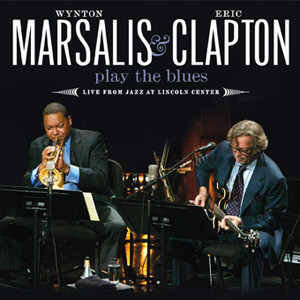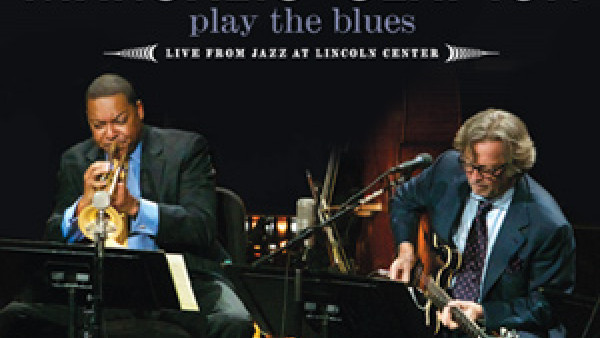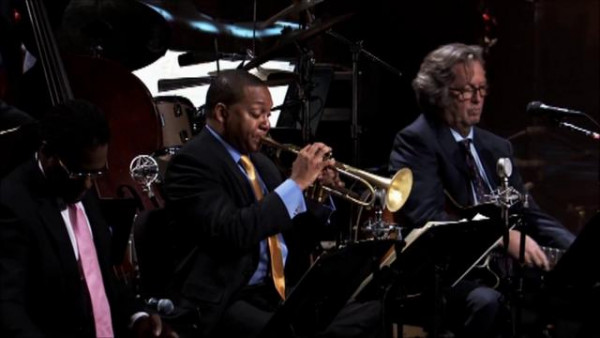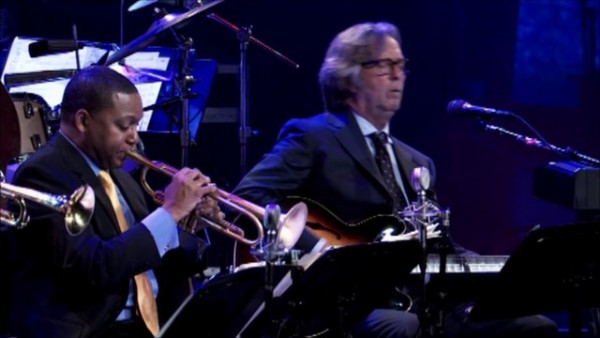Rolling Stone: Eric Clapton, Wynton Marsalis Play the Blues in New York City
“I pat myself on the back – it took a lot of courage to come here,” Eric Clapton said halfway through his show at New York’s Rose Hall on April 8th, glancing and smiling at the men with him on stage: eight members of the Jazz at Lincoln Center Orchestra, including trumpeter and JALC artistic director Wynton Marsalis. Clapton then introduced the next song, nodding over his shoulder at bassist Carlos Henriquez. “This one was foisted on me by Carlos,” the British guitarist said. “I didn’t think it would work.”
Clapton was wrong. “Layla” wasn’t included in the printed program for Wyntom Marsalis and Eric Clapton Play the Blues, two nights otherwise dedicated to a bedrock repertoire of early-jazz tunes and pre-war blues. But the new arrangement, minus the signature guitar lick from Clapton’s 1970 recording with Derek and the Dominos, was a perfect fit: a slow-drag rhythm ringed by mourning horns, recasting the song in the style of the New Orleans lament “St. James Infirmary.” In the instrumental break, Clapton hit a series of stabbing licks lightly crusted with distortion, followed by Marsalis’ slow parade of clean hurting peals – a moving dialogue in lovesickness and blues routes.
Marsalis played on Clapton’s 2010 album, Clapton, a record largely devoted to vintage jazz and blues covers. And in his introductory remarks at the first Rose Hall show, Marsalis spoke of Clapton’s encyclopedic knowledge, noting that the guitarist picked the set list. Clapton, in turn, sang and soloed like a team player. In the opening number, Louis Armstrong’s “Ice Cream,” Clapton locked into a rapid-fire strum with banjo player Don Vappie. Clapton complemented Victor Goines’ crying-clarinet break in W.C. Handy’s slow march “Joe Turner’s Blues” with a chorus of deep long-sob notes. And in a version of Bessie Smith’s 1925 recording “Careless Love,” Clapton coursed through the brass and rhythm tumult with curt phrases in a dirty country-blues tone.
Coming Home
It was fascinating to hear Marsalis and the JALC players – who also included trumpeter Marcus Printup, trombonist Chris Crenshaw, pianist Dan Nimmer and drummer Ali Jackson – move closer to Clapton’s take on tradition. (The guitarist brought his own piano player as well, longtime sideman Chris Stainton.) In Howlin’ Wolf’s “Forty-Four,” Marsalis and Printup dogged Clapton’s vocal and guitar with clipped bursts of trumpet, mimicking the sharp metallic temper of a Chicago blues harp.
Clapton’s choice of guitar – a wide-body Gibson instead of a Fender Stratocaster, his instrument of choice for decades – meant a vintage turn in his sound too, back to the gritty aggression of his playing in John Mayall’s Bluesbreakers and the early Cream, with less volume. In the second high-stepping half of “Just a Closer Walk With Thee,” Clapton uncorked a fast decisive break that recalled the fluid poise of his classic “Crossroads” solo. And in the encore, “Corrine, Corrina,” with vocals by the evening’s opening act, Taj Mahal, Clapton stalked the rhythm in a low menacing register, then bolted upstairs like he’d thrown off a leash.
There was no mistaking the formality of the occasion: the uptown setting and tailored suits; the musicians bolted to their seats (except Henriquez), playing with exacting devotion a music of rough truths and defiant uproar. But the euphoria was in the details, like the way Clapton and Mahal sang the last choruses of “Corrine, Corrina,” in rough happy voices as the band roiled around them. Earlier, Marsalis told the audience that the show was a celebration of “the international power of the blues.” For Clapton, it was more like homecoming. At one point in the evening, he paused to reminisce: “I used to say to all the bluesmen I met, ‘I’m just doing this until I get a gig with a jazz band.’”
He played with this one like he belonged.
By David Fricke
Source: Rolling Stone




